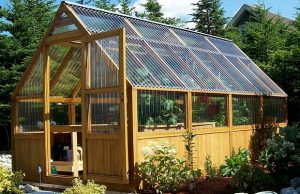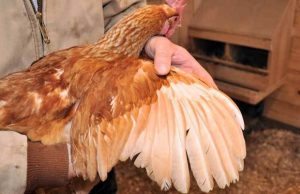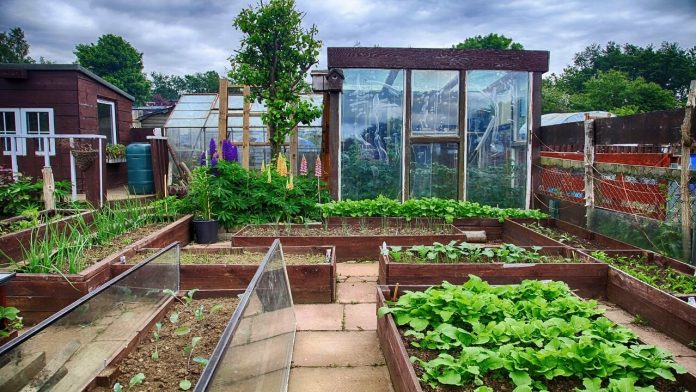A lot of people love the idea of being self-sufficient in produce, but just don’t see it as an achievable goal. After all, how many of us really have access to enough land to even come close to self-sufficiency?
Well, you might be surprised. Just one acre of land is enough to make you pretty much self-sufficient if you’re smart about how you farm it, and an acre isn’t actually all that large. Technically an acre is the area of a rectangle one chain by one furlong, but almost nobody knows what these measures are anymore. In everyday units, an acre is a square about 70 yards on a side – roughly two-thirds the size of a football field. If your property covers an acre, you can run it as a smallholding that will supply most of your food needs.
You do need to be smart about it, of course. An acre isn’t a lot of land, so conventional farming techniques aren’t going to work for you. But, if you set about it the right way, you’ll be able to produce a surprising amount of food.
Planning
On a one-acre farm, it’s not enough to just mark out some fields and start growing stuff. You need to make sure you’re getting the best use from each part of your land. Before you even pick up a shovel, work out exactly what you’re going to do.
Start with a map of your land, and mark any areas that can’t be farmed. That includes buildings, obviously, but also rivers, ponds, and boggy patches. Next, take a walk around and examine the soil in each part of the plot. If there are different soil types, mark on the map where they’re found.
Consider the local climate, because that’s going to affect what you grow. Semi-arid conditions or long, cold winters rule out some crops and make others more practical. Check how long your growing seasons will be; use local climate data from the National Weather Service if you’ve recently moved into the area.
Once you have a detailed map of the plot you can start working out where things are going to go. As well as actual crops there are a few items you’ll need to plan for:
- You’ll need sheds to store equipment and supplies. Look for locations that have easy access to where the shed’s contents will be used, and to the transport network. If you get ten tons of fertilizer delivered you don’t want to be carrying sacks by hand because the truck can’t get to your storage shed. You also don’t want to take up prime fertile land for infrastructure, so try to put it on less useful land.
- Using greenhouses can extend growing seasons and even let you grow crops that wouldn’t usually survive in your local climate. They don’t have to be expensive, either – clear plastic sheeting over a lightweight frame is often all you need. What matters is that it lets sunlight in, but doesn’t let heated air rise away. Greenhouses can also raise humidity if you have a dry climate. Things to grow in them include tomatoes, soft fruits, and even flowers – selling cut flowers is a great way to generate some income from your farm.
- Even if you’re a vegetarian, livestock is an important part of a small farm. Manure is free fertilizer, and if you get the right livestock it will eat a lot of the waste produced on your plot. If you’re not a vegetarian, you can be producing your own eggs, meat and dairy products. With one acre of land available, you need to find ways to raise livestock without taking up land that could be used for crops.
Now that you’ve planned the basics, let’s look at everything in a bit more detail.
Related: What Is Your SHTF Plan?
Setting up infrastructure
You don’t need a lot of infrastructures to run a one-acre farm, but you will need some. Mainly, you need storage for supplies, equipment and some kinds of produce. That basically means having a barn. If your property already has a barn, you’re in luck; if not you’ll need to build one.
A barn only needs to be big enough that you can store things in an organized way. Bins for feed and fertilizer, some more for root vegetables you’ve harvested, and enough space that you can store any machinery and have space to work on it. You can farm an acre without any machinery, but a compact tractor and some attachments will make life a lot easier – and you’ll need them if you expand your plot in the future.
If possible, locate the barn near your house on hard standing. That makes it easy for deliveries.
Greenhouses
 Depending on your local soil and climate, greenhouses can be very useful – or even essential. The temperature and humidity inside will be higher, which opens up new options. A kerosene heater will extend growing seasons even more, without costing much in fuel.
Depending on your local soil and climate, greenhouses can be very useful – or even essential. The temperature and humidity inside will be higher, which opens up new options. A kerosene heater will extend growing seasons even more, without costing much in fuel.
You have two options for greenhouses. They can be built directly over ground-planted crops to give them extra protection, or you can grow small, high-value plants in boxes or pots. That lets you grow to produce on land that isn’t suitable for planting.
If you don’t get a lot of high winds, a lightweight greenhouse is easy and cheap to build. A light framework of wooden or aluminum, covered with a plastic sheet, will do fine. A greenhouse like this can also be dismantled and stored through the winter or moved to different locations as you rotate crops.
Crops
You have four main options for your one-acre farm:
- Potatoes and sweet potatoes
- Root vegetables – carrots, turnips, rutabaga, and beets
- Salad vegetables – lettuce and cabbage
- Legumes – peas and beans
Generally, you’ll want to grow more than one crop in each category, to add some variety, but don’t go too far – more crops means less efficiency, and if your farm is split into dozens of tiny plots, each with a different crop in it, you’ll find your time being eaten up very quickly. Aim for three of each. That means you’ll have twelve plots, each with a different crop.
To achieve this you need to divide your available land into fifteen plots, so you can practice crop rotation. If you try to grow the same crop on a plot year after year you’ll quickly notice yields starting to fall, and you’re more likely to lose crops to parasites or disease. To avoid this, use each plot for a different crop every year, so you don’t strip all the nutrients out of the soil – and, every fifth year, leave the plot fallow; give it a year off. That, combined with growing peas or beans one of the other years, will preserve the soil. Fallow plots can be planted with grass or a grazing crop, like clover.
Related: How I Grow My Herbs Indoors
Livestock
 With only an acre to farm on, you don’t want to take up space with grazing animals. It is possible to keep a cow, but then you’ll need to use some land for growing winter fodder as well. It’s easier to stick with some simpler livestock options:
With only an acre to farm on, you don’t want to take up space with grazing animals. It is possible to keep a cow, but then you’ll need to use some land for growing winter fodder as well. It’s easier to stick with some simpler livestock options:
- Chickens, ducks and geese are all easy to keep, don’t need much feed, and are very productive. They’ll keep you supplied with both eggs and meat, giving you an economical source of protein. Don’t build expensive poultry houses: keep your birds in movable chickenwire enclosures, and put them on your fallow plots. A 15×20-foot enclosure with a built-in nesting box will hold a dozen chickens, and can be easily moved every few days by a couple of people. The birds will forage for insects, worms and seeds to supplement their feed. Fit a hatch so you can access the nesting box from outside the enclosure and collect eggs.
- Goats are another useful animal. Their milk can be used to make cheese, they’re a good, fast-growing source of meat, and they’ll eat just about anything. Fence off your fallow plots and you can let goats graze on them. If your plots are around 50 feet square, you can two goats in there. Move them to a new plot every few days.
- A couple of pigs will eat most of your kitchen waste as well as discarded greens from root crops. If you have an oak tree on your property, pen them under it in autumn and they’ll happily eat the acorns. Pigs just need a dry place to sleep and shelter from the sun; they can get sunburned. A low plywood hut with some straw bedding will be fine.
With your fallow plots and some feed, you can easily keep three dozen birds, half a dozen goats and a pair of pigs. That will give you about 300 pounds of pork, 100 pounds of goat and all the goat’s milk and eggs you can use. It also means that you might not be growing crops on the fallow plots, but they’re still producing food for you – that’s the sort of efficiency you’re looking for on a one-acre farm.
With some creativity, you can come up with ways to get food even from parts of your land that seem totally useless. If there’s a boggy patch, see if it’s suitable for growing cranberries. Got a pond? You might be able to raise catfish in it. Wall gardens can produce a surprising amount of lettuce and other small vegetables by using the vertical dimension efficiently. An acre isn’t a lot of land, but with some imagination and work you’ll be amazed how much food you can get from it.











